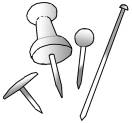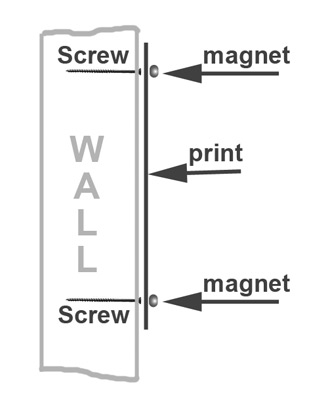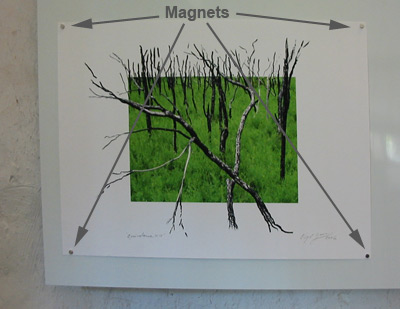Fixing
prints to the wall
While
there is a wide range of ways to fasten work to the wall it is useful
to remember that the texture of the wall surface can play a part in
the effectiveness of the adhesion; some tapes which work fine on a glossy
wall might lose adhesion on a mat surface. Also heat humidity differences
from one environment to another or within the same exhibition space
can play a role in the tape or fixing losing adhesion.
With various
tapes and Velcro dots etc there is often a problem between gaining adhesion
on the surface that will last for the duration of the exhibition and
then removing the adhesive at the end of the show.
Blue
Tack
In some
temporary situations blue tack can work surprisingly well. However it
is not recommended as a long-term option and should be removed from
the back of the work as soon as the work comes down off the wall.
Glues
•
Methylcellulose paste – as this paste expands a small amount makes a
great volume. This is a sound archival paste, which can easily be reconstituted
with water if it turns to a solid. Like wise if it is used to fix a
print to a backing board or on a paper hinge it can be soaked off in
water.
Pins
 While
there is a range of suitable pins available to fix work to a wall each
type of pin carries its own aesthetic weight. Often the nature of the
wall might dictate the type of pin used. For instance the Thumb pins
an easily bend with harder materials.
While
there is a range of suitable pins available to fix work to a wall each
type of pin carries its own aesthetic weight. Often the nature of the
wall might dictate the type of pin used. For instance the Thumb pins
an easily bend with harder materials.
Tapes
There
is a wide range of tapes for fixing work to the wall or fixing them
to a mat board. There is also a huge difference between the quality
and effectiveness of these tapes. Many tapes like Sellotape and double-sided
tape contain acid, or other contaminants, which attack the fibres of
the mat and photograph over a period of time. This can show up in as
little as 4-5 years a yellow staining that gets progressively worse
over time. These tapes can lose their adhesion over a period of time,
with the work falling off the wall and being permanently damaged.
Velcro
Dots
Clips
Eyelets
There
is a wide range of eyelets available that can be used to create a solid
hole at the corner or edge of a print. However be aware that the eyelet
can create problems when the prints are stored one on top of another,
and it is recommended to place several layers of tissue paper between
each print. Its is also a good idea to store the prints face to face
and back to back.
Also over
time some eyelets can have the paint chipped off and rust, which can
migrate onto the surface of the print.
Consider
that fibre prints absorb moisture and in the process tend to expand
while plastic materials are more inert and less susceptible to this.
Magnets
Small magnets are a very effective means of sucuring a print to a wall or a metalic base.

|
Screws and be placed in the wall at the corners of the print and the magnets will be attracted to the metal securing the print without physical damage. |
 |
Or metal sheets can be suspended and the magnets applied at any position. |